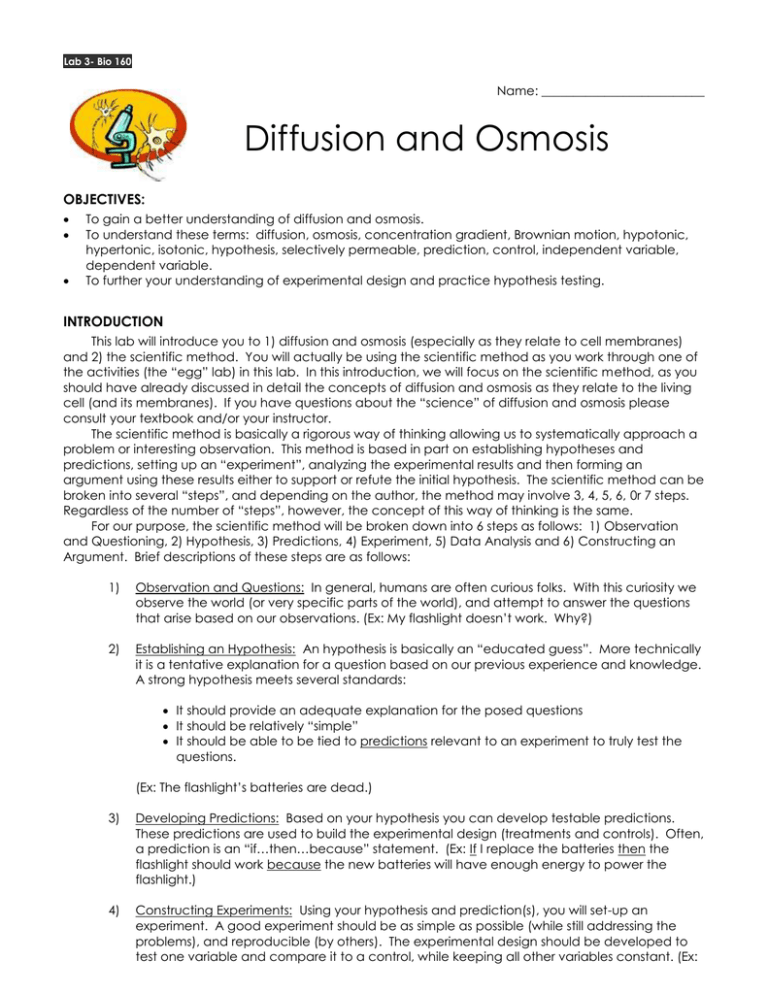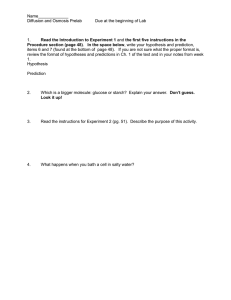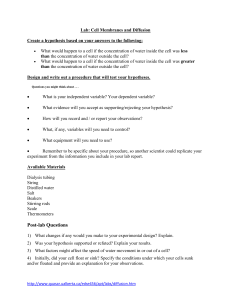Diffusion and Osmosis OBJECTIVES:
advertisement

Lab 3- Bio 160 Name: __________________________ Diffusion and Osmosis OBJECTIVES: To gain a better understanding of diffusion and osmosis. To understand these terms: diffusion, osmosis, concentration gradient, Brownian motion, hypotonic, hypertonic, isotonic, hypothesis, selectively permeable, prediction, control, independent variable, dependent variable. To further your understanding of experimental design and practice hypothesis testing. INTRODUCTION This lab will introduce you to 1) diffusion and osmosis (especially as they relate to cell membranes) and 2) the scientific method. You will actually be using the scientific method as you work through one of the activities (the “egg” lab) in this lab. In this introduction, we will focus on the scientific method, as you should have already discussed in detail the concepts of diffusion and osmosis as they relate to the living cell (and its membranes). If you have questions about the “science” of diffusion and osmosis please consult your textbook and/or your instructor. The scientific method is basically a rigorous way of thinking allowing us to systematically approach a problem or interesting observation. This method is based in part on establishing hypotheses and predictions, setting up an “experiment”, analyzing the experimental results and then forming an argument using these results either to support or refute the initial hypothesis. The scientific method can be broken into several “steps”, and depending on the author, the method may involve 3, 4, 5, 6, 0r 7 steps. Regardless of the number of “steps”, however, the concept of this way of thinking is the same. For our purpose, the scientific method will be broken down into 6 steps as follows: 1) Observation and Questioning, 2) Hypothesis, 3) Predictions, 4) Experiment, 5) Data Analysis and 6) Constructing an Argument. Brief descriptions of these steps are as follows: 1) Observation and Questions: In general, humans are often curious folks. With this curiosity we observe the world (or very specific parts of the world), and attempt to answer the questions that arise based on our observations. (Ex: My flashlight doesn’t work. Why?) 2) Establishing an Hypothesis: An hypothesis is basically an “educated guess”. More technically it is a tentative explanation for a question based on our previous experience and knowledge. A strong hypothesis meets several standards: It should provide an adequate explanation for the posed questions It should be relatively “simple” It should be able to be tied to predictions relevant to an experiment to truly test the questions. (Ex: The flashlight’s batteries are dead.) 3) Developing Predictions: Based on your hypothesis you can develop testable predictions. These predictions are used to build the experimental design (treatments and controls). Often, a prediction is an “if…then…because” statement. (Ex: If I replace the batteries then the flashlight should work because the new batteries will have enough energy to power the flashlight.) 4) Constructing Experiments: Using your hypothesis and prediction(s), you will set-up an experiment. A good experiment should be as simple as possible (while still addressing the problems), and reproducible (by others). The experimental design should be developed to test one variable and compare it to a control, while keeping all other variables constant. (Ex: The batteries are the variable: the new batteries are the “treatment” and the old batteries are the “control”. All other variables are kept constant by using the same flashlight and not changing anything else except the batteries.) 5) Data Analysis: The results of the experiment(s) are analyzed in light of the hypothesis and prediction(s) already established. The researcher must determine if the results between the experimental treatment and the control are statistically significant. Statistical tests are often used to measure the “differences” between the two. 6) Constructing an Argument: If the differences are determined to be statistically significant, then an argument may be constructed to support your initial hypothesis. If the results are not statistically significant, then an argument may be constructed to refute your initial hypothesis and an alternate hypothesis must be proposed. A scientific argument relies on evidence gained from experiments to support or refute an explanation for a natural phenomenon. For the egg lab, described below, you will set-up hypotheses and predictions. Since this is our first time hypothesis testing, we have already set-up the experimental design and you will follow it as written below. After the experiment, you can analyze the results and construct your argument about whether to support or refute your initial hypothesis (and therefore, propose an alternate hypothesis). In addition to the egg lab, you will work on one other activity (the effects of solutions on Elodea leaves), and you will observe several demonstrations illustrating other concepts studied in class (Brownian motion and diffusion across a semi-permeable membrane). The procedures for these are all described below. MATERIALS (per group) FOR THE “EGG LAB” three prepared eggs scale or balance three beakers 3 weigh boats tray for containing the eggs, etc. paper towels unknown solution A (for one egg) unknown solution B (for one egg) control solution (for one egg) MATERIALS (to share) FOR THE PLASMOLYSIS LAB Elodea or Water sprite plant sprigs slides and cover slips 40% NaCl solution Squirt bottles of distilled H2O MATERIALS (for Demonstrations) microscope slide of dilute India ink dialysis slide filled with starch solution beaker of water with I2KI (Lugol's solution) added cards for illustrating the dialysis demonstration GENERAL INFORMATION 1. Work in groups (the size of the groups will be determined by the size of the class and by the amount of equipment available). PROCEDURES Brownian Motion (Demonstration) In order to understand how substances pass through a membrane, it is important to realize that molecules are in constant motion. Molecular motion is a form of energy: the translational, vibrational, and rotational kinetic energies of molecules. Although individual atoms are impossible to see here, their existence is revealed by the jiggling--called Brownian motion--of minute particles suspended in water. 1. Observe the demonstration set up on the microscope. We have placed a solution with small particles (dilute India ink) on a slide and set it up under a microscope at high power (400X). 2. Answer the questions provided on the data sheet below. Selectively Permeable Membrane (Demonstration) 1. A demonstration dialysis slide (selectively permeable membrane) and a beaker of solution with the following contents will have been set-up before class: Contents of Dialysis Slide Water Starch Contents of Beaker Water Iodine 2. This selectively permeable membrane has pores that are big enough to allow the diffusion of water and iodine but are too small to allow the transport of the macromolecular starch. Based on an understanding of the dialysis membrane and your recollection of the reaction between starch and iodine, what are your predictions regarding the movement of water molecules and solute particles when the dialysis slide is placed into the beaker? (Record on data sheet below) 3. Record the results of the demonstration experiment and construct an argument regarding your predictions on the data sheet below. Osmosis The “Egg Lab”: Determining the Relative Concentration of Two Solutions by Osmosis In this portion of the lab, you will be given three solutions. Your job is to determine which is the hypertonic solution and which is the hypotonic solution. You will be able to do this by using "model cells". We will model cells by using eggs. “Eggs??!!” you exclaim. Yes, eggs! They have been specially prepared to make the eggshell soft by soaking them in vinegar. This makes them selectively permeable to water. 1. Based on your understanding of the scientific method from the reading above and any further explanations, fill out the Hypothesis and Prediction sections of Table 2. Your hypothesis should be a general statement about osmosis; while, your prediction should be a specific statement about the expected outcome of the experiment. Often predictions are framed as “If…then…because” statements. This should be done before the experiment takes place. (Either do this before class or in lab directly before you set-up the experiment. Since this is the first hypothesis testing we have done, you can work together and/or ask the instructor for assistance.) 2. To begin the experiment (after your hypothesis and predictions have been written) carefully weigh each egg (gently drying it off beforehand). Use the weighing dish to prevent the egg from rolling off the balance. Record the data in the appropriate section of Table 2. 3. Place each egg into a beaker with solution for 30 minutes, keeping track of which egg went in which beaker! 4. After exactly 30 minutes, remove each egg, dry it off, and weigh it again as in #2. Record the data in the appropriate section of Table 2. 5. Analyze your data and construct an argument about your hypotheses and predictions based on this analysis. Plasmolysis -- Observing Osmosis in a Living System If a plant cell is immersed in a solution that has a higher solute concentration than that of the cell, water will leave/enter (circle one) the cell. The loss of water from the cell will cause the cell to lose the pressure exerted by the fluid in the plant cell’s vacuole, which is called turgor pressure. Macroscopically, you can see the effects of loss of turgor in wilted house plants or “limp” lettuce. Microscopically, increased loss of water and loss of turgor become visible as a withdrawal of the plasma membrane from the cell wall (plasmolysis) and as a decrease in the size of the vacuole (Figure 1). Figure 1. Plasmolysis in an epidermal cell of a leaf: (a) Under normal conditions, the plasma membrane is pressed against the cell walls. A large vacuole occupies the center of the cell, pushing the cytoplasm and nucleus to the periphery. (b) When the cell is placed in a solution with a higher concentration of solutes than that of the cell, water passes out of the cell, and the cell contents contract. (c) In an even more concentrated solution, the cell contents contract still further. 1. Obtain a leaf from an Elodea or Water sprite plant. Place it in a drop of water on a slide, cover it with a coverslip, and examine the material first at low power (100X) and then at high power (400X). 2. Locate a region of healthy cells and sketch a few adjacent cells in the left box of Table 3 below. Note especially the location of the chloroplasts. (Don’t forget to include total magnification.) For the next step, do NOT move the slide. 3. While touching one corner of the coverslip with a piece of Kimwipe to draw off the water, add a drop of concentrated salt solution to the opposite corner of the coverslip. Be sure that the salt solution moves under the coverslip. Wait about 5 minutes, then examine as before. 4. Sketch in the right box below the same cells you sketched in step 1. Diffusion in Agar Cells: (Illustration of the relationship between diffusion and cell size) In this portion of the lab, you will be given a block of agar that you will cut into 3 sizes. We will use these 3 size blocks to demonstrate the effect of size on diffusion. The agar has been made with phenolphthalein in it, which will act as a color indicator when it comes in contact with the base used in the experiment. 1. Each group will cut 3 agar cubes (a 3 cm cube, a 2 cm cube, and a 1 cm cube) from the block of agar available. Cut as accurately as possible. 2. Pour 200 ml of 0.1 M NaOH solution into the 400 ml beaker. Note the time and immerse the 3 blocks in the NaOH solution. Let the cubes soak for 10 minutes. 3. After the 10 minute soak, remove the agar cubes and blot them dry with a paper towel. 4. Promptly cut each cube in half and measure the depth to which the pink color has penetrated. In other words, measure from one edge how far to the center the pink color penetrated. Record your results in the table provided. DATA SHEET – LAB 3 NAME: _________________________________ Brownian Motion Demonstration Do the particles move randomly or in a definite path? Can you see the water molecules? Are the water molecules moving? Is the movement of a particle due to the movement of its own molecules or to bombardment by water molecules? Explain. Would an increase in temperature increase or decrease the rate of Brownian movement? Explain. Selectively Permeable Membrane Demonstration: Pre-experiment Hypothesis: (instructor provided) This selectively permeable membrane will allow the free diffusion of water and iodine but inhibit the diffusion of starch. Pre-experiment Predictions: Table 1: Your Pre- and Post- observations from the Dialysis Slide Demonstration Dialysis Slide Beaker Pre-experimental contents Water, Starch Water, Iodine Pre-experimental color Post-experimental color Is there evidence of the diffusion of starch molecules? If so, in which direction did starch molecules diffuse? Is there evidence of the diffusion of iodine molecules? If so, in which direction did iodine molecules diffuse? What can you say about the permeability of the dialysis slide? (What particles could move through and what particles could not?) And what argument can you construct based on your predictions? (Using your evidence, were you correct or incorrect with your predictions?) Egg Experiment Table 2. Hypothesis: Prediction: Experimental egg A B C Data Pre-soak weight Post-soak weight Data Analysis Post- minus pre-soak weight Interpretation (circle one): support reject the Hypothesis. Construct an Argument (if supported, why; if rejected, why; use evidence) If rejected, a corrected hypothesis: Reasoning (why you corrected the hypothesis the way you did): Elodea Leaf or Water sprite Plasmolysis Experiment Table 3. Sketch your Elodea leaf or water sprite cells here. Be sure to note your magnification and label your drawings! Water salt water added Elodea Leaf or Water sprite Plasmolysis Experiment continued: What happened to the Elodea or Water sprite cells placed in salt water? Assuming that the cells have not been killed, what should happen if the salt solution were to be replaced by water? Does cell turgor (rigidity) influence the overall turgor of the plant part (such as leaf or stem)? Can plant cells burst due to osmosis alone? Explain. Diffusion in Agar Cells Table 4: Results of the agar cell diffusion experiment Cube Surface Area Volume Surface Area to (cm2) (cm3) Volume Ratio 1 cm 2 cm 3 cm Diffusion Depth (mm) Diffusion Rate (mm/min) What effect did size have on the depth that the NaOH reached into the cell? Did the NaOH reach the center for any of the cells? How can these results be used to explain the limit of growth in a living cell?


